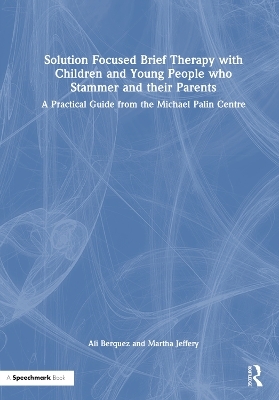
Solution Focused Brief Therapy with Children and Young People who Stammer and their Parents
Routledge (Verlag)
978-1-032-39374-2 (ISBN)
This book offers speech and language therapists, and other allied health professionals, a practical resource for working in a distinctive way with children and young people, and their parents, to achieve their ‘best hopes’ from therapy. The authors share a wealth of knowledge and experience from the Michael Palin Centre for Stammering about how they use Solution Focused Brief Therapy to enhance their practice. This resource manual:
Provides a step-by-step guide to starting solution-focused conversations, having follow-up meetings, drawing attention to what’s working, and ending well.
Illustrates work with a broad range of clients who stammer, including clients with additional physical, learning, and emotional needs.
Demonstrates the benefits of working systemically with children and young people and their parents or carers.
Supports therapists to develop skills in working collaboratively with clients on what they want to achieve from therapy.
Gives examples of how to ask helpful questions and have hope-filled conversations.
Considers the benefits and challenges of working in a solution-focused way.
Describes how to adapt solution-focused conversations according to the client’s age and stage.
Presents a range of applications of SFBT including in groups and in clinical supervision.
The manual is illustrated by a rich variety of case examples which brings the material to life and enables the reader to apply the principles to their own setting. It is an essential practical resource for therapists hoping to develop their skills in empowering parents and in supporting children and young people towards living their best life.
Ali Berquez is Clinical Lead Speech and Language Therapist (SLT) at the Michael Palin Centre (MPC), a Registered Certified European Stuttering Specialist and Chair of the UK’s National Stammering Clinical Excellence Network. She contributes to the Centre’s clinical work and development of therapy programmes, teaching, writing, and research, and offers clinical supervision to therapists in and outside the MPC. Ali started training in Solution Focused Brief Therapy (SFBT) with BRIEF in London in 1999 and completed a BRIEF certificate in Solution Focused Practice in 2019. Her SFBT research has focused on exploring parents’ and children’s expectations from therapy and what parents and children notice over time. Martha Jeffery is a Highly Specialist SLT at the MPC. Before speech and language therapy, she had a former life in conference organisation and banking. She came across SFBT in her first job as an SLT in 2009, but it wasn’t until she started at the MPC in 2013 that it became embedded in her practice. Over time, she learned not to dread the ‘What have you been pleased to notice?’ question in team meetings and supervision and to enjoy the way it turned her perspective around. She has an Advanced Certificate in Solution Focused Brief Therapy from BRIEF’s year-long programme in 2021.
List of figures
Foreword by Evan George
Preface
Acknowledgements
1 Introduction
You (the reader) and SFBT
An introduction to Solution Focused Brief Therapy
A brief history of SFBT at the Michael Palin Centre
Current thinking about stammering and how SFBT helps us
Our assessment process and SFBT
How we use SFBT in therapy – an eclectic approach
2 Our First Solution-Focused Conversation
Meeting the person, not the problem
Exploring best hopes
Looking for solutions and what’s already working using scaling
Compliments
Summing up and ending the session
3 Progress over Time
What’s going well
Thinking more about scaling and best hopes
Broadening the view of self
When it’s not going so well
Process of change and coping with setbacks
How to manage diverging hopes
Follow-up sessions with young adults
When to meet again
Ending therapy
4 Solution-Focused Conversations with Children and Young People
Talking to younger children
Exploring best hopes with younger children
Exploring the concept of scaling
Using metaphors and imagery
Talking to young people
Children and young people with learning or language needs
Autistic children and young people
Children and young people with physical disability
Children and young people with emotional health needs
5 Solution-Focused Conversations with Parents
Why include parents?
Parenting children who stammer
Parenting children with additional needs
Working systemically
6 Using SFBT in Groups
Working in groups
The benefits of group therapy
7 The Evidence Base, the Benefits, and the Challenges
The evidence base for SFBT
Benefits of SFBT
Challenges of SFBT
Frequently asked questions
8 Other Applications of SFBT
Exploring a stammering ‘toolkit’ using a SF perspective
Handling criticism using SFBT
SFBT in other settings
9 Becoming a Solution-Focused Therapist
Therapist skills
Using SFBT in supervision
10 Conclusion
Resources
Bibliography
Index
| Erscheinungsdatum | 25.04.2024 |
|---|---|
| Zusatzinfo | 5 Line drawings, black and white; 38 Halftones, black and white; 43 Illustrations, black and white |
| Verlagsort | London |
| Sprache | englisch |
| Maße | 210 x 297 mm |
| Gewicht | 625 g |
| Themenwelt | Geisteswissenschaften ► Psychologie ► Allgemeine Psychologie |
| Geisteswissenschaften ► Psychologie ► Biopsychologie / Neurowissenschaften | |
| Geisteswissenschaften ► Psychologie ► Verhaltenstherapie | |
| Medizin / Pharmazie ► Gesundheitsfachberufe ► Logopädie | |
| ISBN-10 | 1-032-39374-2 / 1032393742 |
| ISBN-13 | 978-1-032-39374-2 / 9781032393742 |
| Zustand | Neuware |
| Informationen gemäß Produktsicherheitsverordnung (GPSR) | |
| Haben Sie eine Frage zum Produkt? |
aus dem Bereich


